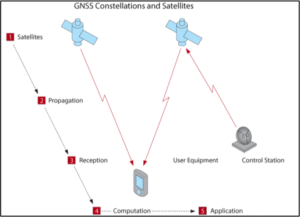Value Proposition – Truck GPS Data
 Basic GNSS systems geo-locate a user device in five operational steps, illustrated in the figure.
Basic GNSS systems geo-locate a user device in five operational steps, illustrated in the figure.
- Satellites: GNSS satellites orbit the earth in precise orbits closely monitored by ground-based control stations that adjust satellite paths and onboard atomic clocks.
- Propagation: GNSS satellites regularly broadcast precise location, time, status, and error adjustment information.
- Reception: GNSS user equipment receive transmitted information packets from four or more satellites.
- Computation: GNSS user equipment triangulates location by comparing time and position of satellite data, adjusting for errors as possible.
- Application: GNSS user equipment provides the computed position and time to the end user application, for example, navigation, surveying or mapping.
The GPS device movement creates a series of time-stamped coordinates, which can be used to derive various attributes, infer trip ends, and finally construct O-D information.
Several U.S. states and non-U.S. jurisdictions have enacted laws establishing personal location privacy rights. However, current U.S. statute at the federal level does not provide clear protection of geolocation information. Members of Congress have proposed legislation to prevent misuse of such information by law enforcement, companies, and individuals. These include the Geolocation Privacy and Surveillance Act (“GPS Act”), the Online Communications and Geolocation Protection Act, and the Location Privacy Protection Act. As of October 2017, none of these bills has been enacted into law. Another evolving area is the right of the federal, state and local regulatory agencies to collect, retain, use and disseminate electronic location data recorded and maintained by companies in their business operations. In the trucking industry, the Federal Highway Administration (FHWA) has initiated a pilot project that allows participating motor carriers to voluntary use GPS tracking systems to monitor compliance with the hours-of-service (HOS) requirements of the Federal Motor Carriers Safety Regulations and exempt drivers from maintaining paper logs.
Ownership falls into two categories (Hard et al, 2016): Public and private sector ownership. Public agency ownership where the agency collects primary GPS Data. Primary GPS data are raw, unprocessed GPS data collected through first-hand means such as using GPS tracking devices in vehicles to obtain travel-time data. Few agencies collect primary GPS data. Private sector GPS Data. There are two types of private sector data sources. Third party providers, such as HERE, TomTom, INRIX, or StreetLight, continuously collect, purchase, and compile GPS data from a variety of sources for eventual sale to businesses or government agencies. These data can be expensive to procure. GPS data acquired from these third-party providers will be pre-processed to anonymize it and/or to provide it in pre-established formats and outputs. The scale at which the anonymization and aggregation happens is a critical consideration, too much detail could raise privacy concerns, but too much aggregation could restrict the data utility. The second type are companies that generate GPS data (such as trucking fleets) but hesitate to monetize and share it. Public-private sharing agreement which are mutually beneficial may be necessary to gain access to this second type of private sector data.
To fully extract value from high-resolution GPS / GNSS data and be able to verify its completeness, transportation agencies need a way to streamline the storage of large data sets and develop capabilities to analyze and visualize these data to inform performance measures. Many of these routines are automated using GIS and other analytical software, and decision-makers can rely on visual dashboards. Agencies interested in minimizing hardware, software, IT, and analytics capabilities can subscribe to services from specialist vendors.
There are GPS trace data is likely be more intensively employed by certain classes of road users, such data may not provide a representative OD sample suitable for more general use.